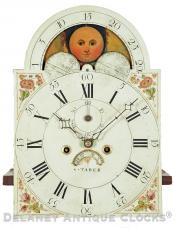Stephen Taber of New Bedford, Massachusetts. Tall case clock. RR-36.
This very nice inlaid mahogany case features excellent mahogany veneers and retains an older, if not ant an original, finish. The finish is not dry. The case form reflects a strong Boston influence. This fine example stands on four nicely shaped ogee bracket feet. The base panel is framed with a thin line inlay border. In each of the four corners are quarter fans consisting of five petals. The mahogany wood selected for the base panel features an interesting grain pattern that radiates from a central knot in the wood. The waist section is long and fitted with a large rectangular waist door decorated with the same line and quarter fan inlay pattern shown in the base. This door is trimmed with applied molding. This door opens to access the interior of the case. The sides of the waist are fitted with brass stop-fluted quarter columns and terminate in brass quarter capitals. The bonnet is of the fretwork style, and the three fluted plinths are surmounted with brass ball and spike finials. Brass stop-fluted bonnet columns flank the bonnet door. These are mounted in brass capitals. The door opens to access to a colorfully painted iron dial.
This dial is signed "S. Taber" in block lettering above the numeral six within the time track. The time track or time ring is formatted with Roman numeral style hour makers. Each of the five-minute markers and the subsidiary seconds ring are displayed in Arabic numerals. In the arch of this dial is a lunar calendar or moon phase mechanism. The four spandrel areas are decorated with gilt patterns.
The time and strike brass constructed movement is weight powered and designed to run for an eight-day duration. It is of excellent quality.
This clock was made circa 1805 and stands approximately 7 feet 6 inches tall to the top of the center finial.
Inventory number RR-36.
Stephen Taber was born on October 23, 1777, in New Bedford, Massachusetts, and died there on September 10, 1862. His older brother Elnathan was nine years his senior and had moved North to Roxbury, where he served his clockmaking apprenticeship under Simon Willard. Simon considered Elnathan a highly skilled mechanic and his best apprentice. Elnathan remained in Roxbury after his indenture and continued to build clocks for himself and others in the Roxbury group of Clockmakers. Because of Elnathan's success, it is logical to assume that Stephen was also attracted to the clockmaking community in Roxbury. Stephen was trained in Boston by Aaron Willard, Simon's younger brother. By 1798, Stephen is recorded in the town of Roxbury's Tax Records as a Roxbury resident. This would suggest that he moved to Roxbury to start his apprenticeship sometime in 1791-92 at the age of 14. After serving his apprenticeship, he stayed in Roxbury for one year and returned to New Bedford in 1799. Here he advertised in October of that year that "Stephen Taber, (Late apprentice to Mr. Aaron Willard, Clock-Maker in Boston) Respectfully informs the public That he carries on the Clock Making Business... at his shop in Union Street..." From this time until he died in 1862, it appears that he lived and worked primarily in New Bedford. He is also listed as working in Acushnet for a short time. Over the later part of his life, the extent of his clockmaking trickled off as the years passed. This is assumed because he was more commonly listed as a merchant or trader by 1810. By 1860, his estate was valued at over $100,000. At the time of his death in 1862, his wealth had almost doubled. He married Elizabeth Sprague Pitcher in 1824. After he died in 1862, she became a philanthropist. She was one of the founding members of Tabor Academy in the town of Marion.






